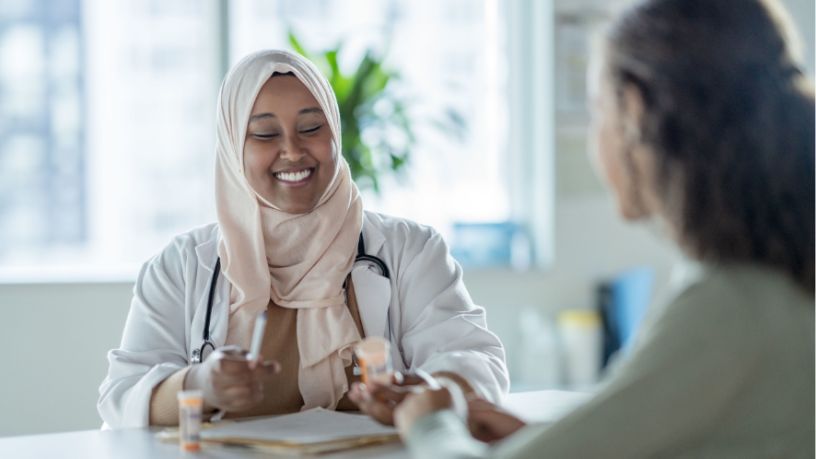Endometriosis can cause extreme pain and fertility issues.
On this page
Key takeaways
Treatments include medication, complementary therapies (like acupuncture) and surgery.
New guidelines aim to reduce diagnosis time and improve treatment and outcomes for Australian patients.
Endometriosis is a painful condition that affects one in 9 Australian women, girls and those assigned female at birth at least once in their lifetime.1
Despite being a common condition, it can take on average 6 to 8 years to get a diagnosis.2 This can be for many reasons, including:
- symptoms being confused for period pain or other conditions
- a lack of investment in research and treatment
- diagnosis requiring either surgery or a specialised ultrasound.3
New guidelines for GPs and other healthcare providers aim to increase awareness, speed up diagnosis and offer more effective treatment.
What is endometriosis?
Endometriosis Australia describes the condition as "a disease where tissue similar to the lining of the womb grows outside it in other parts of the body".
Although endometriosis mainly impacts the reproductive organs, it can also be present around the bladder and bowel, and even in the skin, joints and brain.4
What are the common signs and symptoms?
"The cardinal symptoms of endometriosis are pain with periods, pain with intercourse and difficulty falling pregnant," says Dr Anusch Yazdani, an advanced reproductive endo-surgeon and Medical Director of Endometriosis Australia. "But anything that is cyclical should raise the suspicion that there is a potential problem. Things like cyclical bloating or gastrointestinal disturbances that aren't related to periods.
"Other symptoms include pain in other regions, frequent headaches [and] bowel or bladder abnormalities. That might include frequency of urination and pain when you're emptying your bladder and bowels. This is often diagnosed as irritable bowel syndrome (IBS) but may be part of the endometriosis.
"We also often see changes of pelvic floor function, so pain when you're sitting down, pain when you're exercising, feeling like you have a knot in your pelvis."
Other symptoms can include:5
- heavy or irregular bleeding
- fatigue
- brain fog
- having trouble holding on when you have a full blader, or increased urgency
- pain in your pelvic area, lower back or legs.
Why has endometriosis been so hard to diagnose?
Historically, it has taken many years for someone to be diagnosed with endometriosis. This is something Dr Yazdani says the new guidelines may help to improve.
"It used to take around 17 years to diagnose endometriosis from the time a person sought help for symptoms. In 2012 this dropped to 5 years, and now it has reduced to just under 2 years, though the number of doctors seen to get a diagnosis is still high at 4. These reductions are primarily the result of increased awareness driven by organisations such as Endometriosis Australia."
The problem is still that it takes up to 3 years from when the symptoms start until most people seek help from their doctor.
Dr Yazdani says there are many reasons why diagnosis takes so long and why people don't seek help sooner.
"There used to be a huge amount of gaslighting. Doctors saying, ‘it's just periods, you're just being a woman'. Happily, a lot of the medical misogynism that exists within this space is disappearing. Also, women [and people who are transgender or gender diverse] are now much more empowered to say ‘no, this isn't right' and to seek second opinions. The online community has grown significantly, so [people] can ask questions about what others are experiencing which gives them confidence to advocate for themselves."
Dr Yazdani also suggests that period pain has been overly normalised, and people have become adept at living with unacceptable levels of pain.
"Period problems often run in families. If you've seen your sister [or sibling] take time off from school with period pain, or your mum [or parent] take time off work, it's been normal to you. Women [and people who have periods] are also incredible at managing pain and period symptoms; they just get on with it."
How much period pain is too much?
Because everyone experiences pain differently (or has a different ‘pain threshold') it's been difficult to assess how bad a patient's pain is. Instead of a one to 10 scale of pain, Dr Yazdani asks what impact the pain is having on a person's life.
"I want to know how much periods and pain are interfering with life. It might mean that you don't like going out socially. You don't like exercising. You're worried about things. Intimacy is not the way that it should be. This is how we know there is a problem."
How is endometriosis diagnosed?
Historically, endometriosis was diagnosed through a surgical procedure called a laparoscopy. While this is still often used, because endometriosis can present differently, Dr Yazdani says a patient's history can somewhat predict the presence of the condition. The best non-invasive test is currently an ultrasound performed by someone specialising in endometriosis.
"We can make a provisional diagnosis with an ultrasound scan, and there are also some new diagnostic tools coming including blood tests with increased sensitivity. While the definitive diagnosis relies on surgery, not everyone with endometriosis needs surgery."
How is endometriosis treated?
Dr Yazdani says there is now a more holistic approach to endometriosis.
"In the past, the treatment of endometriosis was being juggled by a GP, then finally referred to a specialist who would operate and that's it."
"The modern approach to endometriosis and pelvic pain is in an interdisciplinary team, where we work with physiotherapists, acupuncturists, nutritionists, counsellors, surgeons, fertility specialists, nurses and psychologists. And of course, the most important person at the centre of the treatment is the patient and what is important to [them]."
It's got to be more than, 'you have this lump, we're going to cut it out and you're on your own'. We need to treat the whole person, not just one part of [them].
Surgery to remove the endometriosis can relieve some symptoms, but according to Dr Yazdani, it may not fix everything.
"There is good evidence showing that where the deposits are removed or destroyed you can improve fertility and reduce pain. But there is also good evidence that repeat surgery is not the answer. If the endometriosis is gone but the pain remains, we need to address that. There are non-steroid medications, hormonal treatments, and the contraceptive pill still shows good results in the management of those symptoms."
While it is common to be able to remove all endometriosis and not have a recurrence, some pain can remain.
"The symptoms will not always disappear. That's why instead of endometriosis surgical centres we now have endometriosis centres of care that can provide interdisciplinary care for patients."
How to get help with endometriosis
If you think you may have endometriosis, the most important thing you can do is find a doctor who will listen and advocate for you, says Dr Yazdani.
"If something is interfering with your life, don't put up with it. You know what is best for you. Not every specialist or GP will get the right answer immediately, so it's important to persist and get another opinion. Speak up and demand to be listened to."
It's equally important that to advocate for young people who may be experiencing troubling symptoms.
"With young women and teenage girls [and gender diverse people], we must take them seriously. If you have a young [person] who is cyclically having problems, not wanting to go to school, not wanting to interact and [they're] withdrawing more and more, get [them] seen by a doctor."
Resources
Endometriosis Australia offers resources to help you manage endometriosis symptoms.
Endozone provides information about symptoms, diagnosis and treatment and support for self-managing endometriosis. They also have a symptom checker tool and a share personal stories.
Find more government recommended resources here.
Many thanks to Dr Yazdani, a subspecialist in reproductive endocrinology and infertility, an advanced reproductive endo-surgeon, Medical Director of Endometriosis Australia and a fertility specialist and Associate Professor at Monash IVF.
In this article we use the terms 'men' and 'women' to include both cisgendered men and women, and those who were assigned 'male' or 'female' at birth, but whose gender identity now differs.

At Bupa, trust is everything
Our health and wellbeing information is regularly reviewed and maintained by a team of healthcare experts, to ensure its relevancy and accuracy. Everyone's health journey is unique and health outcomes vary from person to person.
This content is not a replacement for personalised and specific medical, healthcare, or other professional advice. If you have concerns about your health, see your doctor or other health professional.
1Australian Government, Department of Health and Aged Care. (2024). What we’re doing about endometriosis. Australian Government.
2Australian Institute of Health and Welfare. (2023). Endometriosis. Australian Government.
3Endometriosis Australia. (2022). Why is it so difficult to get an endometriosis diagnosis?. Endometriosis Australia.
4Endometriosis Australia. (2025). Your guide to endometriosis. Endometriosis Australia.
5Endometriosis Australia. (2025). Endometriosis resources. Endometriosis Australia.
You might also like...
5 ways women can support healthy ageing
Small changes to your daily life can have a big impact on your health as you age. Discover 5 ways to support women’s healthy ageing.
How to know when you're ovulating
If you’re trying to conceive, you may want to know when you’re ovulating each month. We look at the signs of ovulation and some ways to track your cycle.
Different types of contraception: The pros and cons
Contraception is continually evolving, with new information and options becoming available all the time. Find one that’s right for you.
9 ways to make the most of your GP check-up
Doctor’s appointments can feel overwhelming and there can be a lot to get through in a short amount of time. So how can you get the most out of your GP visit?





